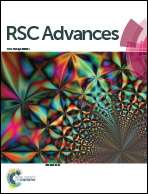The impact of phenyl–phenyl linkage on the thermodynamic, optical and morphological behavior of carbazol derivatives†
Abstract
The impact of structural differentiation between phenylcarbazoles (PhC, mCP, CBP, TCB) and phenylamines (TPA, BDB, TPB, TDAB) on the phase equilibria, optical spectrum, band gap, and thin-film morphology is evaluated and discussed. The carbazolyl units lead to a lower electronic conjugation contributing to a wide band gap when compared with the diphenylamine analogs. The fusion and sublimation equilibria indicate that entropic contribution is the key factor for the distinguished melting behavior and solid-phase volatility between phenylcarbazole derivatives and phenylamine analogs. The molecular differentiation between the two classes of compounds is not reflected in the crystal packing and intermolecular interactions. However, compared with the diphenylamino groups, the incorporation of carbazolyl moieties contributes to a less flexible molecule. Moreover, the results evidence that intermolecular bonding disruption along the fusion transition is more extensive for phenylamine derivatives. Due to the asymmetric nonplanar structure, mCP is characterized by a ratio of {Tg/Tm ≈ 3/4} while the more symmetric CBP and TCB molecules display ratios closer to {Tg/Tm ≈ 2/3}. Vapor-deposited thin films of mCP, CBP, and TCB are amorphous and their morphology is highly dependent on the substrate roughness. The lower flexibility of nonplanar phenylcarbazoles induces the formation of a glassy state due to the harder packing mechanism leading to the lower ability of the crystallization process.



 Please wait while we load your content...
Please wait while we load your content...